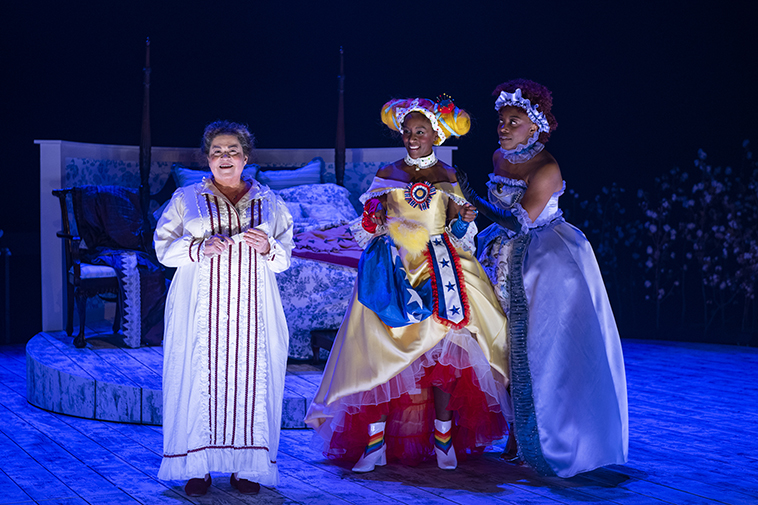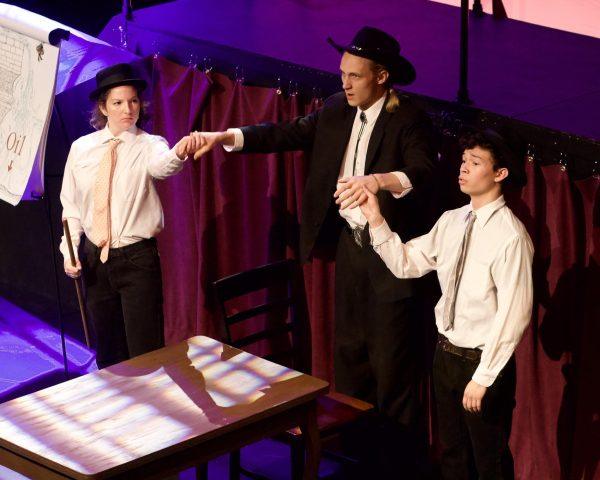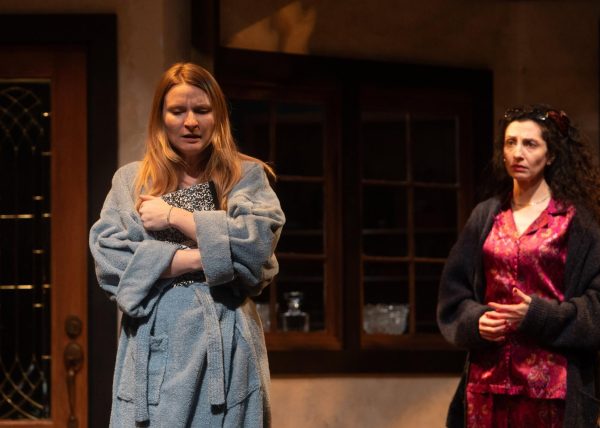Steppenwolf’s “Miz Martha” is a Feverish, Elaborate, and Infuriatingly Didactic Production
Associate Arts Editor Zachary Leiter reviews Steppenwolf’s fall dramedy about the final moments of the nation’s first First Lady.
Fantastical versions of Betsy Ross (Celeste M. Cooper) and Abigail Adams (Sydney Charles) visit Miz Martha Washington (Cindy Gold) in a dream.
October 19, 2022
Shown this fall at Steppenwolf Theatre, James Ijames’s The Most Spectacularly Lamentable Trial of Miz Martha Washington is a grotesque, dark, darkly humorous, and energetic exploration of America’s original sin: slavery. On a stage ringed by cotton fields, the Pulitzer Prize–winning Ijames depicts Miz Martha Washington’s feverish final moments in bed. When she dies, her hundreds of slaves will be freed by George Washington’s will. As Miz Martha lies in her deathbed, caught between terrible dreams and an even more frightening present, the play focuses on whether the widow will willingly free her slaves before they kill her.
I say Miz Martha because the character is not intended to be true to life but rather a personification of America. At one point, she even states, “I am the mother of America.” At another point, a dream figure says to her, “You are America. … And I am here to examine America.” The result of the play’s cultural trial for America’s original sin is never up for question here: This is an unabashedly didactic play, but perhaps that is the only way to treat the material at hand safely. And so my challenge is to evaluate a play lacking almost entirely in contemplation but with abundant humor, bright performances, and sharp technical execution. On to the action.
The fact that the play’s events happen at Christmastime is easy to forget but for a tense and sad moment when Ann Dandridge (Nikki Crawford) reminds her son William (Victor Musoni) that their Christmas must be put aside to serve Miz Martha. As the lights go down at the play’s open, the festively lit facade of Mount Vernon at center stage rises into the rafters, never to return. The rest of the play takes place in Miz Martha’s sparsely decorated bedroom and in her mind. A smartly designed bed platform moves up and down stage, distinguishing between dream and reality. But as the play progresses, the distinction becomes less and less clear. Fewer of Miz Martha’s dreams are spectacular, and more and more of them take place at Mount Vernon, with her slaves in attendance.
The decor in Miz Martha’s bedroom, and Clint Ramos’s scenic design as a whole, is fantastic. The backdrops are simple yet evocative, the shadows cast that the cotton fields cast across the stage are haunting, and the bedroom is eerily contemporary in design. Everything feels intentional, and those intentions are largely successful: This is a play in which nothing and no one feels out of place. Everything fits right in—that is, except for the constant references to the 21st century. Characters speak largely in more modern English. William tells Miz Martha the story of the United States—a recounting that goes quite a few years past their own present. One dream sequence is of a lit-up game show, another of a contemporary courtroom where Miz Martha is put on trial. For the record, the latter montage is entertaining, whereas the former is overly silly. The effect of it all is to drive home that slavery’s legacy extends into the modern era. Miz Martha’s reckoning, if extreme, is one with which we must all contend for ourselves and for our nation.
Cindy Gold, as Miz Martha, does well to keep her character from becoming a caricature; the role’s role within the play is to provide a starting point from which to explore national complicity. Again, the woman’s own complicity is never really up for debate, nor is the issue of whether she will realize her moral failures. Gold does well to bring depth of expression and a genuinely comedic stage presence to a character whose moral code is lacking. Another strong performance comes from Carl Clemons-Hopkins as Davy. In various dream roles, including a velvet-adorned George Washington, Hopkins is always convincing and often quite humorous. Celeste M. Cooper as Doll and Sydney Charles as Priscilla have an entrancing rapport—watching them together on stage, one actually believes they have spent their lives together. And overall, Steppenwolf’s ensemble comes through strongly. All seven of Miz Martha’s cast members move well together on stage, crafting what is at times a masterpiece of mise-en-scène.
This is a showcase of miraculous tonal shifts, where the enslaved people go from faux reverence to unrestrained laughter in a matter of seconds and where the audience is led to believe, at the very end, that Miz Martha has maybe just been reformed. Sitting together with him on her bed, Miz Martha tells William a semi-biblical story of the future summertime, when she and he will walk hand in hand. “That time is a ways away,” he replies. This answer seems to soothe Miz Martha’s conscience back into complacency. She orders William to fetch her water; gone then is any change of heart that her fever dreams brought about, to include a vision of her being sold into slavery by a sparkly Uncle Sam. To be free, she says at one point, “is the most marvelous of feelings.” To Miz Martha, freedom is freedom from responsibility.
And, I fear, that might be what freedom is for this play. Miz Martha renders judgment on Miz Martha and on her nation, but it does not linger to explore that judgment’s consequences. The play’s brisk runtime (90 minutes without intermission) is a strength with regard to the sharp execution of vision, but it prevents the characters and the audience from dwelling long on the implications of Ijames’s premise. Miz Martha is a tremendous artistic success, though perhaps a shallow one.













